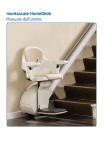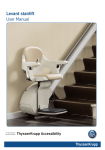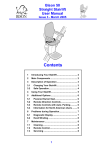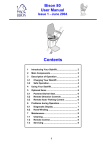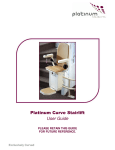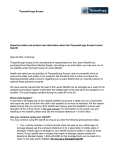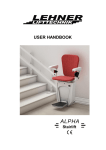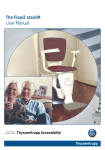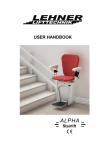Download HomeGlide stairlift User Manual
Transcript
HomeGlide stairlift User Manual HomeGlide stairlift User Manual ATTENTION READ THIS USER MANUAL CAREFULLY BEFORE USING THE STAIRLIFT PAY SPECIAL ATTENTION TO THE CHAPTER ‘SAFETY INSTRUCTIONS’ KEEP THIS MANUAL IN THE VICINITY OF THE STAIRLIFT SO THAT YOU WILL ALWAYS HAVE THE INFORMATION YOU NEED AVAILABLE © 2009 ThyssenKrupp Accessibility B.V. 1000537 V1.1 All rights reserved. Nothing in this document may be reproduced and/or published by means of printing, photocopy, microfilm or any other means whatsoever without the prior written permission of ThyssenKrupp Accessibility B.V. HomeGlide stairlift Table of Contents Preface 3 Safety instructions 6 1. Introduction 9 2. Operation 2.1 Operating parts 2.1.1 Call and send stations 2.1.2 Control unit 2.1.3 Main switch 2.2 Use of the stairlift 2.2.1 Calling the stairlift 2.2.2 Unfolding the chair 2.2.3 Sitting down on the chair 2.2.4 Driving the stairlift 2.2.5 Rising from the chair 2.2.6 Folding up the chair 2.3 Signals during normal use 11 11 11 12 12 13 13 14 15 15 17 17 17 1 HomeGlide stairlift 2 3. Warning signals 3.1 Warning and alarm signals 3.2 Examples 3.2.1 Stopping during the ride 3.2.2 Obstacle on the staircase 3.2.3 Batteries not sufficiently charged 18 18 19 19 19 19 4. Maintenance and service 4.1 Cleaning 4.2 Changing the batteries of the call and send station 4.3 Preventive maintenance 4.4 Technical specifications 4.5 Contact 20 20 20 21 22 23 HomeGlide stairlift Preface Congratulations! You have chosen a stairlift produced by ThyssenKrupp Accessibility. A modern, user-friendly and safe product that will give you years of service. We will do everything possible to justify the confidence you have placed in us. To make the best possible use of the stairlift, it is important to read these instructions carefully before first using the HomeGlide. These instructions These instructions are meant for you as the user of the HomeGlide stairlift. The instructions contain all necessary information for the correct and safe use of the stairlift. In the instructions the words “left”, “right”, “front” and “back” are used to indicate a certain part of the stairlift. Here the basic premise is always the position of you as the user, sitting on the stairlift. 3 HomeGlide stairlift Symbols In this user manual the following symbols will be used: TIP Tips for and advice about the correct performance of a procedure. WARNING Risk of severe physical injury in the event of failure to comply with the instructions in full. CAUTION Risk of damage to (parts of) the stair lift and/or minor physical injury in the event of failure to comply with the instructions in full. 4 HomeGlide stairlift Stairlifts and the environment Batteries The stairlift contains two batteries for the supply of the electrical motor, 12 V (7 Ah). These batteries may only be replaced by authorised engineers. The user may replace the batteries in the call and send stations. Do not deposit old batteries with household wastes but turn them in when you buy the new batteries. If this is not possible, consult your Local Authority to determine the recommended disposal. Disposing of the stairlift Stairlifts that are no longer in use are often taken back by your dealer after consultation. If this is not possible, consult your Local Authority to determine the possibility of recycling them or other environmentally friendly ways of processing the materials. 5 HomeGlide stairlift Safety instructions General Your HomeGlide stairlift has been designed for maximum user-friendliness in domestic households. To ensure that the stairlift is operated correctly, it is important that every user is aware of the instructions in this user manual. You, as end user of the stairlift, are always completely responsible for compliance with local safety requirements and directives. ThyssenKrupp Accessibility is therefore not responsible for damage or injury caused by failure to correctly observe the safety requirements and directives as described in the user manual, or improper use during the use or maintenance of the stairlift. Warning stickers on the stairlift The warning stickers on the HomeGlide stairlift are an important part of our safety measures. The stickers may therefore not be covered or removed and must always be visible and legible. If the warning stickers are unreadable or damaged, they must be replaced immediately. You can contact your supplier for this. Users -- Only adults who are aware of the contents of the instructions are permitted to use the stairlift. -- Minors and the mentally handicapped may only use the stairlift under supervision. -- The stairlift is exclusively intended for the transportation of one person per ride. -- Never exceed the maximum capacity allowed (permissible weight: 300 lb North America / 127 - 138 kg Europe). -- Do not use the stairlift to transport animals or goods. -- Never change the sequence of the actions to be performed! 6 HomeGlide stairlift -- Keep children away from the stairlift. Do not let them play with the stairlift. Use -- Before use, inspect both the stairs and the stairlift. Use the stairlift only when the stairs are free from obstruction. Be sure there are no obstacles in or on the rail. -- In case of an automatic hinge rail make sure that the moveable part will not be obstructed by any objects. -- Practice with the stairlift until you are fully able to execute all procedures. -- Be careful of loosely hanging articles of clothing (shawls, belts, jackets, wide skirts, etc.). Be sure they do not become caught in the moving parts of the stairlift. -- Never stand on the stairlift. Sit on the seat and always use the safety belt. -- Remain seated upright during travel. Do not lean back or forward. Do not make any unnecessary movements. -- During travel keep your hands on the armrests. -- Keep your feet neatly on the footrest. Do not let them protrude outside the footrest. -- Do not fold or unfold any parts of the stairlift violently. -- Report unusual sounds or vibrations immediately to your supplier. -- Protect the stairlift against water or moisture. -- Keep the control units free of dirt and grease. 7 HomeGlide stairlift Technical specifications The major parts that can be found in chapter 1.2 should not be altered. Maintenance -- Never do repairs on the stairlift yourself. Changes or replacements of parts of the stairlift are only permitted by ThyssenKrupp Accessibility authorised/trained personnel. -- Only carry out maintenance that is described in these instructions. WARNING Never remove the main power supply cable from the wall outlet, or switch off the power since the charging of the batteries will then not occur. Do not remove any labels that belong to the stairlift. -- For N.America it is required to carry out regular inspections and tests to Standard A18.1.10. -- To comply with these requirements please contact your supplier/ installation engineer (see 4.5 for details). 8 HomeGlide stairlift 1. Introduction 1.1 General description The HomeGlide is a custom made stairlift with which you can safely and comfortably use a staircase without any physical exertion. The stairlift can transport one person per ride. The HomeGlide is driven via an electrical motor that is supplied by means of rechargeable batteries. The charging of the batteries takes place at the stop places (top and bottom of the stairs). The HomeGlide can be operated in two ways: -- Seated on the stairlift you operate the lift by means of the control unit, situated in one of the armrests. -- If the stairlift is not at the place where you wish to seat yourself in it, you can bring the lift to the desired place via the optional wireless call and send stations. These call and send stations are kept in a holder on the wall, at the top and bottom of the stairs. To limit loss of space when the stairlift is not in use, the armrests, the seat and the footrest can be folded up. If the rail forms an obstruction at the lower landing (like blocking a doorway), the rail can be equipped with an automatic hinged part. 9 HomeGlide stairlift 1.2 Major parts In figure 1.1 you see a schematic overview of the HomeGlide stairlift. The major parts are indicated with lines. TIP Figure 1.1 shows the standard arrangement for a right-handed user with the control unit on the right hand armrest. Description figure 1.1: d c e b f a g h i Fig. 1.1: Major parts 10 a. folding seat b. rail c. control unit d. backrest e. folding armrest f. safety belt g. swivel seat handle h. drive unit i. folding footrest HomeGlide stairlift 2. Operation This chapter first gives a description of the controls for operation. Then the operation of the lift is described, with all the procedures that occur in daily use. 2.1 Operating parts The most important controls are: -- The wireless call and send stations. -- The wired control unit in the armrest. TIP All buttons on the call and send station and the joystick on the control unit are hold to run. This means that only by holding a button or switch activated will the stairlift move. The lift will make an audible signal prior to any movement (also see chapter 2.3) 2.1.1Call and send stations The wireless call and send stations (figure 2.1) are kept in a holder on the wall at the top and bottom of the stairs. With the aid of these stations you can move the stairlift up or down. 11 HomeGlide stairlift a d a b Fig. 2.1: Call and send station a. Call and send buttons b. Holder Fig. 2.2: Control unit TIP The stairlift will not move if the joystick is not placed in the control unit. 2.1.2Control unit As soon as you insert the joystick in the control unit, you can, while sitting on the seat, control the stairlift with a single hand movement. The control unit is mounted on the right armrest in the factory. 2.1.3Main switch With the main switch you can turn the HomeGlide stairlift on and off (for instance when you will go on a holiday, or when you are not at home for a long time). 12 HomeGlide stairlift 2.2 Use of the stairlift CAUTION Before use read the safety instructions carefully. 2.2.1Calling the stairlift TIP Keep in mind that the buttons on the Call and Send stations are hold to run. As soon as you release the buttons, the stairlift stops. Before you push the call button, check if the staircase is free from obstacles. Then push the call button of the call and send station (see figure 2.1) and keep it pushed until the stairlift has arrived at the stop place. TIP In case of an automatic hinge rail the stairlift will automatically stop on a special contact before it reaches or leaves the hinged part. Keep the call button pushed, the hinged part will fold down or up and the stairlift will continue. 13 HomeGlide stairlift 2.2.2Unfolding the chair The stairlift is available at the stop place in a folded position (figure 2.3). You can unfold the stairlift as follows: c b - Fold down the footrest (a). - Fold down the seat (b). - Fold down the two armrests (c). a Fig. 2.3: Folded stairlift CAUTION The swivel seat of the HomeGlide can only be swivelled upstairs. TIP The chair can only be turned to one side. When the chair has been turned, the stairlift is electrically disabled. This means that you cannot drive the lift up or down untill the chair is not swivelled back in its initial position by pushing the turning handle downwards shortly. TIP The swivel of the HomeGlide can make the chair turn for 70 degrees. When you pull the handle upwards you can turn the chair towards the desired position. 14 HomeGlide stairlift 2.2.3Sitting down on the chair To easily and safely be seated, you can turn the chair in the correct direction. 1. Unlock the chair by pulling the swivel handle upwards (only upstairs). 2. The chair can now be turned in the correct direction for taking a seat. 3. Sit down on the chair, with your back against the backrest. 4. If you have swivelled the chair, put the chair back into the correct position with the aid of the swivel handle. Otherwise the chair will not move. 5. Put your feet carefully on the footrest. 6. Close the safety belt for your own safety. 2.2.4Driving the stairlift 1. Check if the staircase is free from obstacles. 2. Push the joystick on the control unit left or right to send the stairlift up or down. 3. In case of an automatic hinge rail the stairlift will automatically stop just before it reaches or leaves the hinged part. Keep the call button pushed in, the hinged part will fold down or up and the stairlift will continue. (figure 2.4) 15 HomeGlide stairlift Fig. 2.4: HomeGlide with automatic hinge TIP The joystick on the control unit is hold to run. The stairlift continues driving until you release the joystick or until you have arrived at the end of the ride. TIP A built-in safety feature makes sure that you cannot switch over from one direction of driving to another direction too quickly. Also after a stop, for example halfway up the stairs, the lift starts after a short delay. CAUTION Always park your stairlift on a charging contact. If you do not park the stairlift on a charging contact, the batteries will become empty and you will not be able to use the stairlift. 16 HomeGlide stairlift 2.2.5Rising from the chair To easily and safely rise from the chair, you can turn the chair in the desired rising direction. Unlock the chair by pulling the swivel handle upwards. 1. Open the safety belt. 2. Rise out of the chair. 2.2.6Folding up the chair If you have swivelled the chair, put the chair back to its initial position with the aid of the swivel handle (only upstairs). 1. Fold up the two armrests. 2. Fold up the seat. 3. Fold up the footrest. 2.3 Signals during normal use Signal Meaning A short beep. The stairlift is driving away. Or the call and send station is activated. The stairlift reached the end stop and is on a charging contact. Two short beeps. Continuous slow beeps (only in case of HomeGlide with automatic hinge) The automatic hinge rail is folding or unfolding. 17 HomeGlide stairlift 3. Warning signals Failures may occur. If the stairlift does not work (properly), and you can not solve the problem with this user manual, then call in the help of your supplier. (see chapter 4.5). CAUTION Never try to repair the stairlift yourself. 3.1 Warning and alarm signals Signal Fast beeps that repeat every ten seconds. Fast beeps that continuously repeats. Meaning The stairlift is not on a charging contact, or the power supply is disconnected. -- The stairlift or automatic hinge rail has encountered an obstruction and stopped. -- The seat is not positioned correctly -- There is a malfunction in the stairlift. 18 Solution Drive the stairlift to a charging contact. Connect the power supply. -- Drive away from the obstacle and remove it. -- Turn the seat in its driving position. -- Contact your supplier. HomeGlide stairlift 3.2 Examples 3.2.1 Stopping during the ride If you wish to stop the stairlift during the trip, for example because you wish to return or because you see an obstacle on the staircase, do the following: 1. Release the joystick on the control unit. The stairlift will stop immediately. 2. Remove the obstacle 3. Push the joystick in the desired direction to continue the ride. If you wish to return, push the joystick in the opposite direction 3.2.2 Obstacle on the staircase If an obstacle on the staircase, or a body part, becomes caught between a step and the footrest, the stairlift stops automatically and immediately. You will hear fast short alarm beeps. 1. Push the joystick on the control unit in the opposite direction. This way you can drive away from the obstacle. 2. Remove the obstacle. 3. Return in the original direction of travel. 3.2.3 Batteries not sufficiently charged If the batteries do not have sufficient capacity, you are not able to drive with the stairlift. In the event of the stairlift stopping while driving upstairs, there is always the possibility to drive downstairs. 19 HomeGlide stairlift 4. Maintenance and service 4.1 Cleaning -- Clean the chair of the HomeGlide regularly with a soft, damp cloth and possibly a mild detergent. -- Dust particles can be removed using the vacuum cleaner. -- The rails should regularly be wiped lightly. Be careful not to touch the roller rack. CAUTION Do not use caustic detergents and do not use too much water. 4.2 Changing the batteries of the call and send station In the call and send stations there are two penlight (AA) batteries. When the batteries are empty, you have to replace the batteries (figure 4.1). 1. Open the call and send battery cover 2. Replace the old batteries with the new ones, take care of battery polarity 3. Fit the call and send battery cover 4. Dispose the old batteries to an appropriate waste collecting station 20 Fig. 4.1: Changing the batteries of the call and send stations. HomeGlide stairlift 4.3 Preventive maintenance In addition to cleaning the stairlift, regular maintenance is needed to guarantee that your stairlift will keep working properly. This maintenance should be carried out by authorized maintenance technicians. We therefore advise you to take out a maintenance contract to ensure that your stairlift will stay in optimal condition. Contact your supplier for more information about the maintenance contract. For N.America the HomeGlide sections of the standard A18.1-10 must be used for regular inspections and test. TIP Change the batteries annually. CAUTION Do not throw the old batteries in the household waste, but treat them as Small Chemical Waste. 21 HomeGlide stairlift 4.4 Technical specifications General Europe Capacity (max.) Driving speed (max.) Sound North America Capacity (max.) Driving speed 22 138 kg max 45° 127 kg max 53° 0.12 meters per second < 65 dB (A) 300 lb max 45° 20 Ft/min Electrical system Operating voltages Mains (Europe) 24 V DC rechargeable batteries 240 V 50 Hz 120 V 60 Hz (N.America) Environmental conditions Environmental temperature Relative humidity Electrical system Operating voltages Mains (Europe) 24 V DC rechargeable batteries 240 V 50 Hz 120 V 60 Hz (N.America) 5 - 40 °C 20 - 80% HomeGlide stairlift 4.5 Contact For information about settings, maintenance or other matters that are not addressed in these instructions, you can contact your local contact. Local contact: Name ������������������������������������������������������������������������� Address ������������������������������������������������������������������������� Tel ������������������������������������������������������������������������� 23

























